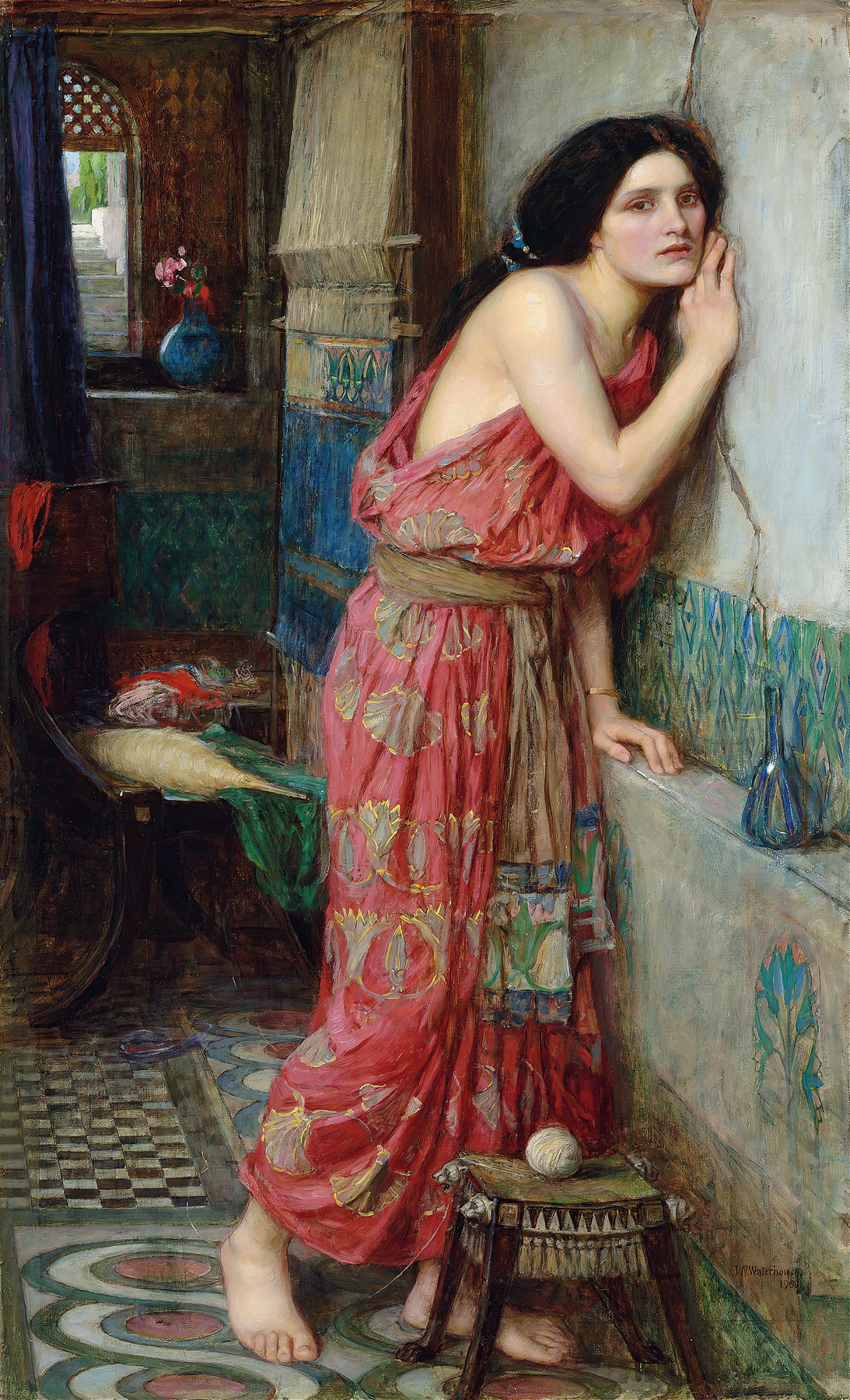Description
Thisbe by John William Waterhouse printed on a Hoodie
Thisbe (1909) depicts a scene from the story of Thisbe and Pyramus, which is part of Ovid’s Metamorphoses. Set in ancient Babylon, Thisbe, a beautiful maiden, falls in love with her neighbor Pyramus, but the two are kept apart by their families, who are bitter rivals and will not allow them to wed. The young lovers use a crack in a wall shared by their families’ homes to communicate with one another: they profess their love and arrange a meeting near Ninus’s tomb. However, a series of tragic circumstances unfold, Thisbe arrives first. After seeing a lioness approach, she runs away leaving her veil behind. Pyramus arrives later, and wrongly assuming Thisbe fell prey to the lioness, he kills himself by falling on his sword. Thisbe returns to find Pyramus’s body under a mulberry tree. In her grief, she stabs herself with the same sword. It is said that the blood of the lovers seeped into the fruit of the mulberry tree, forever giving the mulberry fruit its unique red color.
The story was retold in the late 1300s by Geoffrey Chaucer in Legend of Good, and in 1595, by William Shakespeare in a scene of A Midsummer Night’s Dream, as well as his famous tragedy, Romeo and Juliet. The story of Thisbe is the type of subject that appealed to the artist: an unfulfilled love story that ends with the woman transforming to a natural form. In the same decade, he painted Echo and Narcissus (1903) – Echo dissolves into a whisper after being rejected by Narcissus, and Apollo and Daphne (1908) – Daphne turns into a laurel tree as she flees Apollo.
Thisbe and its companion painting Lamia (1909) were first exhibited at the Royal Academy in 1909, and both were well received by critics. The model, whose identity remains unknown, was a favorite of the artist appearing in the paintings Ophelia (1910) and Penelope and the Suitors (1912). In the painting, Thisbe has risen from her loom and is holding her ear to listen to Pyramus through the crack in the wall. In the artist’s time, the loom, weaving, and embroidery were associated with feminine virtue and domesticity, especially because it was believed that the Virgin Mary was embroidering. In fact, Waterhouse often depicted his heroines weaving, like in I Am Half-Sick of Shadows, Said the Lady of Shalott (1915), and Penelope and the Suitors (1912). Since the story of Thisbe is set in Babylon, Waterhouse added different Oriental elements to the painting. However, his choices were not well researched or historically accurate: the stool in the foreground and the lotuses on Thisbe’s gown are Egyptian, the window transom in the background is Islamic, the tiles lining the right wall are Ottoman and the flooring appears to be Roman. This mishmash of influences reflects Waterhouse’s broad interest in Eastern cultures, and the desire to evoke a distant past through these exotic elements.
About the Hoodie
Modern fit
It provides a more tailored look than a regular fit
Comfortable
The fabric and fit of this item are extra comfy
Tear-away tag
Easily removable tear-away tag that allows you to add a custom inside label
Premium quality
The product is made from premium, high-quality materials
Classic unisex hoodie with a front pouch pocket and matching flat drawstrings. The 100% cotton exterior makes this hoodie soft to the touch.
- 65% ring-spun cotton, 35% polyester
- Charcoal Heather is 60% ring-spun cotton, 40% polyester
- Carbon Grey is 55% ring-spun cotton, 45% polyester
- 100% cotton face
- Fabric weight: 8.5 oz./yd.² (288.2 g/m²)
- Front pouch pocket
- Self-fabric patch on the back
- Matching flat drawstrings
- 3-panel hood
- Tear-away tag
John William Waterhouse (1849 – 1917)
John William Waterhouse RA was an English painter known for working first in the Academic style and for then embracing the Pre-Raphaelite Brotherhood’s style and subject matter. His artworks were known for their depictions of women from both ancient Greek mythology and Arthurian legend.
Born in Rome to English parents who were both painters, Waterhouse later moved to London, where he enrolled in the Royal Academy of Art. He soon began exhibiting at their annual summer exhibitions, focusing on the creation of large canvas works depicting scenes from the daily life and mythology of ancient Greece. Many of his paintings are based on authors such as Homer, Ovid, Shakespeare, Tennyson, or Keats.
Waterhouse’s work is currently displayed at several major British art galleries, and the Royal Academy of Art organised a major retrospective of his work in 2009.
Waterhouse was born in the city of Rome to the English painters William and Isabella Waterhouse in 1849, in the same year that the members of the Pre-Raphaelite Brotherhood, including Dante Gabriel Rossetti, John Everett Millais and William Holman Hunt, were first causing a stir in the London art scene. The exact date of his birth is unknown, though he was baptised on 6 April, and the later scholar of Waterhouse’s work, Peter Trippi, believed that he was born between 1 and 23 January. His early life in Italy has been cited as one of the reasons many of his later paintings were set in ancient Rome or based upon scenes taken from Roman mythology.
In 1854, the Waterhouses returned to England and moved to a newly built house in South Kensington, London, which was near to the newly founded Victoria and Albert Museum. Waterhouse, or ‘Nino’ as he was nicknamed, coming from an artistic family, was encouraged to become involved in drawing, and often sketched artworks that he found in the British Museum and the National Gallery. In 1871 he entered the Royal Academy of Art school, initially to study sculpture, before moving on to painting.
Waterhouse’s early works were not Pre-Raphaelite in nature, but were of classical themes in the spirit of Alma-Tadema and Frederic Leighton. These early works were exhibited at the Dudley Gallery, and the Society of British Artists, and in 1874 his painting Sleep and his Half-brother Death was exhibited at the Royal Academy summer exhibition. The painting was a success and Waterhouse would exhibit at the annual exhibition every year until 1916, with the exception of 1890 and 1915. He then went from strength to strength in the London art scene, his 1876 piece After the Dance being given the prime position in that year’s summer exhibition. Perhaps due to his success, his paintings typically became larger and larger in size.
In 1883, Waterhouse married Esther Kenworthy, the daughter of an art schoolmaster from Ealing who had exhibited her own flower-paintings at the Royal Academy and elsewhere. In 1895 Waterhouse was elected to the status of full Academician. He taught at the St. John’s Wood Art School, joined the St John’s Wood Arts Club, and served on the Royal Academy Council.
One of Waterhouse’s best known subjects is The Lady of Shalott, a study of Elaine of Astolat as depicted in the 1832 poem by Alfred, Lord Tennyson, who dies of a mysterious curse after looking directly at the beautiful Lancelot. He actually painted three different versions of this character, in 1888, 1894, and 1916. Another of Waterhouse’s favorite subjects was Ophelia; the most familiar of his paintings of Ophelia depicts her just before her death, putting flowers in her hair as she sits on a tree branch leaning over a lake. Like The Lady of Shalott and other Waterhouse paintings, it deals with a woman dying in or near water. He may also have been inspired by paintings of Ophelia by Dante Gabriel Rossetti and John Everett Millais. He submitted his 1888 Ophelia painting in order to receive his diploma from the Royal Academy. (He had originally wanted to submit a painting titled A Mermaid, but it was not completed in time.) After this, the painting was lost until the 20th century. It is now displayed in the collection of Lord Lloyd-Webber. Waterhouse would paint Ophelia again in 1894 and 1909 or 1910, and he planned another painting in the series, called Ophelia in the Churchyard.
Waterhouse could not finish the series of Ophelia paintings because he was gravely ill with cancer by 1915. He died two years later, and his grave can be found at Kensal Green Cemetery in London.






Reviews
There are no reviews yet.